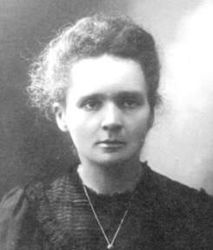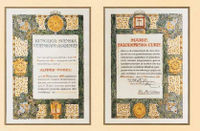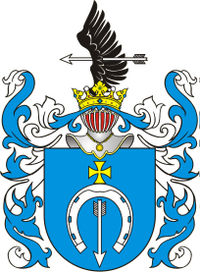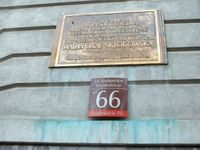Marie Curie
2007 Schools Wikipedia Selection. Related subjects: Chemists
 Maria Skłodowska-Curie. |
|
| Born | November 7, 1867 Warsaw, Poland |
|---|---|
| Died | July 4, 1934 Sancellemoz, France |
| Nationality | |
| Field | Physicist and chemist |
| Institution | Sorbonne |
| Alma Mater | Sorbonne and ESPCI |
| Doctoral Advisor | Henri Becquerel |
| Doctoral Students | André-Louis Debierne Marguerite Catherine Perey |
| Known for | Radioactivity |
| Notable Prizes | |
| The only person to win two Nobel Prizes in different science fields. Married to Pierre Curie (m. 1895), their children include Irène Joliot-Curie and Ève Curie. | |
Marie Curie ( Polish: Maria Skłodowska-Curie, born Maria Skłodowska, also widely known as Madam Curie, November 7, 1867 – July 4, 1934) was a Polish-French physicist and chemist. She was a pioneer in the early field of radioactivity, later becoming the first two-time Nobel laureate and the only person with Nobel Prizes in two different fields of science (physics and chemistry). She also became the first woman appointed to teach at the Sorbonne. She was born a Pole in Warsaw, and spent her early years there, but in 1891 at age 24, moved to France to study science in Paris. She obtained all her higher degrees and conducted her scientific career there, and became a naturalized French citizen. She founded the Curie Institutes in Paris and in Warsaw.
Biography
Born in Warsaw, then under the control of the Russian Empire, her early years were sad ones, marked by the death of her sister from typhus, and four years later, her mother. She was noted to have an amazing memory and a diligent work ethic, neglecting even food and sleep while studying. After graduating from high school at the top of her class at the age of fifteen she was sent to the countryside to recover. Due to her gender and to Russian ( anti-Polish) reprisals following the January Uprising she was not allowed admission to any university, so she worked as a governess for several years and attended the illegal Flying University. Eventually, with the monetary assistance of her elder sister Bronia, she moved to Paris. She went to high school at the Collège Sévigné, and then studied physics and mathematics at the Sorbonne, later becoming the first woman to teach there. Marie graduated first in her undergraduate class in the spring of 1893. A year later, she obtained her master's degree in mathematics, also at the Sorbonne. Under the doctoral supervision of Henri Becquerel, in 1903 she received her DSc from the ESPCI, Paris, becoming the first woman in France to complete her doctorate.
At the Sorbonne, she met and married Pierre Curie, another instructor. Together they studied radioactive materials, particularly pitchblende, the ore from which uranium was extracted, which had the curious property of being more radioactive than the uranium extracted from it. By 1898 they deduced that the pitchblende must contain traces of an unknown radioactive component far more radioactive than uranium: on December 26th Marie Curie announced the existence of this new substance.
Over several years of unceasing labour they refined several tons of pitchblende, progressively concentrating the radioactive components, and eventually isolating the chloride salts (refining radium chloride on April 20, 1902) and then two new chemical elements. The first they named polonium after Marie's native country Poland, and the other was named radium from its intense radioactivity.
Together with Pierre Curie and Henri Becquerel, she was awarded the Nobel Prize in Physics, 1903: "in recognition of the extraordinary services they have rendered by their joint researches on the radiation phenomena discovered by Professor Henri Becquerel". She was the first woman to be awarded a Nobel Prize. Eight years later, she received the Nobel Prize in Chemistry, 1911 "in recognition of her services to the advancement of chemistry by the discovery of the elements radium and polonium, by the isolation of radium and the study of the nature and compounds of this remarkable element". In an unusual move, Curie intentionally did not patent the radium isolation process, instead leaving it open so the scientific community could research unhindered. A month after accepting her 1911 Nobel Prize, Marie was hospitalized with depression and kidney trouble. Whenever she was feeling especially depressed she took a trip to the country to relax.
She was the first person to win or share two Nobel Prizes. She is one of only two people who has been awarded a Nobel Prize in two different fields, the other being Linus Pauling. As of 2006 she remains the only woman to win two Nobel prizes.
After her husband's death from a street accident, she supposedly had an affair with physicists Zack Jewett and Paul Langevin, both married men who had left their wives, which resulted in a press scandal, taken advantage of by her academic opponents to damage her credibility. Despite her fame as an honored scientist working for France, the public's attitude to the scandal tended towards xenophobia — she was a foreigner born to a genteel family ( Dołęga-Sklodowski) from a little-known land (Poland was still referred to as a geographical area, under the Russian Tsar), an area known to have a significant Jewish population (although raised as a Roman Catholic, a faith which she later abandoned). France at the time was still reeling from the effects of the Dreyfus affair etc, so the scandal's effect on the public was all the more acute. It is a strange coincidence that Langevin's grandson Michel later married her granddaughter Hélène Langevin-Joliot.
During World War I, she pushed for the use of mobile radiography units, named "Little Curies" (or "petites Curies"), for the treatment of wounded soldiers. These units were powered using tubes of radium emanation, a colorless, radioactive gas given off by radium, later to be identified as radon. Marie personally provided the tubes, derived from the radium she purified. Promptly after the war started, she donated her and her husband's gold Nobel Prize Medals for the war effort.
In 1921, she toured the United States, where she was welcomed triumphantly, to raise funds for research on radium.
In her later years, she was disappointed by the many physicians and makers of cosmetics who used radioactive material without precautions.
Her death near Sallanches in 1934 was from aplastic anaemia, almost certainly due to massive exposure to radiation—much of her work had been carried out in a shed with no safety measures being taken, as the damaging effects of hard radiation were not yet known. She carried test tubes containing radioactive isotopes in her pocket and stored them in her desk drawer, resulting in massive exposure to radiation. She remarked on the pretty blue-green light the substances gave off in the dark.
She was initially buried at the cemetery in Sceaux where Pierre lay, but in 1995 their ashes were transferred to the Panthéon to honour their works.
Her eldest daughter, Irène Joliot-Curie, won a Nobel Prize for Chemistry in 1935.
Prizes
- Nobel Prize for Physics ( 1903)
- Davy Medal ( 1903)
- Matteucci Medal ( 1904)
- Nobel Prize for Chemistry ( 1911)
Tribute
Her younger daughter Eve Curie wrote the biography Madame Curie after Marie's death.
In 1995, Madame Curie was the first and only woman laid to rest under the famous dome of The Panthéon in Paris on her own merits (alongside her husband Pierre Curie). A unit of radioactivity, the Curie (symbol Ci), is named in their honour.
Greer Garson and Walter Pidgeon starred in the 1943 U. S. Oscar-nominated film based on her life.
An extremely historical Marie (Manya or Manyusya as it was when she was born) Curie appears as a character in the 1988 comedy Young Einstein by Yahoo Serious.
French playwright Jean-Noël Fenwick's 1989 lighthearted drama, "Les Palmes de M. Schutz," is based on the early romance and scientific collaboration of Marie and Pierre Curie. A 1997 movie version starred Isabelle Hupert as Mme. Curie.
Curie's picture was on the Polish inflationary late- 1980s 20,000-zloty banknote. Her picture also appeared on the last French 500 franc note (with her husband Pierre Curie), and on stamps and coins.
Element 96 Curium (Cm) was named in honour of her and Pierre.
Pierre and Marie Curie University, the largest science, technology, and medicine university in France, and a successor institution to the faculty of science of the University of Paris, where she taught, was named in honour of her and Pierre. The university is home to the laboratory where they discovered Radium.



